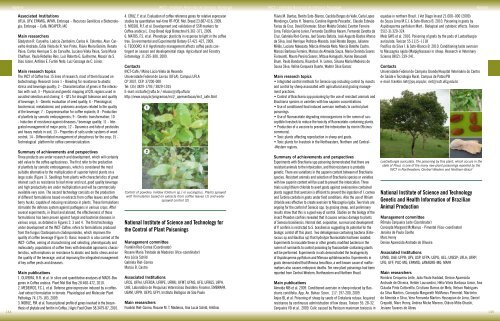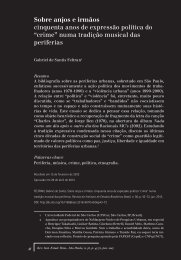livro
livro
livro
You also want an ePaper? Increase the reach of your titles
YUMPU automatically turns print PDFs into web optimized ePapers that Google loves.
Agrárias INCT – Institutos Nacionais de Ciência e Tecnologia<br />
INCT – Institutos Nacionais de Ciência e Tecnologia<br />
Agrárias<br />
Associated Institutions<br />
UFLA; UFV; EPAMIG; IAPAR; Embrapa – Recursos Genéticos e Biotecnologia;<br />
Embrapa – Café; INCAPER; IAC<br />
Main researchers<br />
Gladyston R. Carvalho, Laércio Zambolim, Carlos A. Colombo, Alan Carvalho<br />
Andrade, Édila Vilela de R. Von Pinho, Flávio Meira Borém, Renato<br />
Paiva, Carlos Henrique S. de Carvalho, Luciano Vilela Paiva, Sara Maria<br />
Chalfoun, Paulo Rebelles Reis, Luiz Roberto G. Guilherme, Moacir de S.<br />
Dias Júnior, Antônio E. Furtini Neto, Luiz Gonzaga de C. Júnior.<br />
Main research topics<br />
The INCT of Coffee has 15 lines of research, most of them focused on<br />
biotechnology. Research Lines 1 - Breeding for resistance to abiotic<br />
stress and beverage quality; 2 - Characterization of genes in the interaction<br />
with rust; 3 - Physical and genetic mapping of QTL regions used in<br />
assisted selection and cloning, 4 - QTL for drought tolerance and quality<br />
of beverage; 5 - Genetic evaluation of seed quality; 6 - Phenological,<br />
biochemical, metabolomic and proteomic analyses related to the quality<br />
of the beverage; 7 - Cryopreservation for coffee explants; 8 - Production<br />
of plantlets by somatic embryogenesis; 9 - Genetic transformation; 10<br />
- Induction of resistance against diseases / beverage quality; 11 - Integrated<br />
management of major pests; 12 - Dynamics and fate of pesticides<br />
and heavy metals in soil, 13 - Properties of soils under systems of weed<br />
control; 14 - Differentiated management of phosphorus for the crop; 15 -<br />
Technological platform for coffee commercialization.<br />
4. CRUZ, F. et al. Evaluation of coffee reference genes for relative expression<br />
studies by quantitative real-time RT-PCR. Mol. Breed 23:607-616, 2009.<br />
5. MISSIO, R.F. et al. Development and validation of SSR markers for<br />
Coffea arabica L. Crop Breed Appl Biotechnol 9:361-371, 2009.<br />
6. MATOS, F.S. et al. Phenotypic plasticity in response to light in the coffee<br />
tree. Environmental and Experimental Botany 67:421-427, 2009.<br />
6. TEODORO, A.V. Agroforestry management affects coffee pests contingent<br />
on season and developmental stage. Agricultural and Forestry<br />
Entomology 11:295-300, 2009.<br />
Contacts<br />
INCT-Café / Mário Lúcio Vilela de Resende<br />
Universidade Federal de Lavras (UFLA), Campus UFLA<br />
CP 3037, CEP: 37200-000<br />
Tel: (35) 3829-1793 / 3829-1015<br />
E-mail: inctcafe@ufla.br / mlucio@dfp.ufla.br<br />
http://www.cnpq.br/programas/inct/_apresentacao/inct_cafe.html<br />
Flávio M. Dantas, Benito Soto-Blanco, Cacilda Borges do Valle, Carla Lopes<br />
Mendonça, Carlos H. Tokarnia, Caroline Argenta Pescador., Claudio Estevão<br />
Farias da Cruz, David Driemeier, Edson Moleta Colodel, Everton Ferreira<br />
Lima, Felício Garino Junior, Fernando Castilhos Karam, Fernando Zanotta da<br />
Cruz, Gabriela Riet-Correa, Jael Soares Batista, José Augusto Bastos Afonso<br />
da Silva, José Henrique Pedrosa-Macedo, José Renato Borges, Julianne<br />
Milléo, Luciano Nakasato, Márcia Almeida Melo, Marcio Botelho Castro,<br />
Marcos Barbosa Ferreira, Marcos de Almeida Souza, Maria Clorinda Soares<br />
Fioravanti, Mauro Pereira Soares, Mitsue Haraguchi, Karine Bonucielli<br />
Brum, Paulo Bandarra, Ricardo A. A. Lemos, Silvana Maria Medeiros de<br />
Sousa Silva, Valíria Cerqueira Duarte, Walmir Silva Garcez<br />
Main research topics<br />
• Integrated control methods for Senecio spp including control by insects<br />
and control by sheep associated with agricultural and grazing management<br />
practices.<br />
• Control of Brachiaria spp poisoning by the use of resistant animals and<br />
Brachiaria species or varieties with low saponin concentrations.<br />
• Use of conditioned food induced aversion methods to control plant<br />
poisonings.<br />
• Use of fluoroacetate degrading microorganisms in the rumen of susceptible<br />
livestock to reduce the toxicity of fluoracetate-containing plants.<br />
• Production of a vaccine to prevent the intoxication by ricinin (Ricinus<br />
communis).<br />
• Toxic plants affecting reproduction in sheep and goats.<br />
• Toxic plants for livestock in the Northeastern, Northern and Central-<br />
-Western regions.<br />
equidae in northern Brazil. J Vet Diagn Invest 21:000–000 (2009)<br />
de Souza Lima M.C.J. & Soto-Blanco B. 2010. Poisoning in goats by<br />
Aspidosperma pyrifolium Mart.: Biological and cytotoxic effects. Toxicon<br />
55(2-3):320-324.<br />
Melo GWS et al. 2010. Poisoning of goats by the pods of Luetzelburgia<br />
auriculata. Toxicon 55:1115–1118<br />
Pacífico da Silva I. & Soto-Blanco B. 2010. Conditioning taste aversion<br />
to Mascagnia rigida (Malpighiaceae) in sheep. Research in Veterinary<br />
Science 88(2): 239-241.<br />
Contacts<br />
Universidade Federal de Campina Grande/Hospital Veterinário do Centro<br />
de Saúde e Tecnologia Rural, Campus de Patos/PB<br />
e-mail: franklin.riet@pq.cnpq.br; riet@cstr.ufcg.edu.br<br />
Summary of achievements and perspectives<br />
Three products are under research and development, which will certainly<br />
Summary of achievements and perspectives<br />
add value to the coffee agribusiness. The first refer to the production<br />
of plantlets by somatic embryogenesis, which is considered the most<br />
suitable alternative to the multiplication of superior hybrid plants on a<br />
Experiments with Brachiaria spp poisoning demonstrated that there are<br />
resistant animals to the intoxication, and that resistance is probably<br />
genetic. There are variations in the saponin content between of Brachiaria<br />
Luetzelburgia auriculata. The poisoning by this plant, which occurs in the<br />
state of Piauí, is one of the many new plant poisonings reported by the<br />
INCT in Northeastern, Central Western and Northern Brazil<br />
large scale (Figure 1). Seedlings from plants with characteristics of great<br />
species. Resistant animals and selection of Brachiaria species or varieties<br />
interest such as resistance to leaf miner and rust, good quality beverage<br />
with low saponin content will be used to prevent the intoxication. Three<br />
and high productivity are under multiplication and will be commercially<br />
trials using lithium chloride to avert goats against swainsonine contained<br />
available very soon. The second technology consists on the production<br />
of different formulations based on extracts from coffee leaves and coffee<br />
berry husks, capable of inducing resistance in plants. These formulations<br />
stimulate the defense system against pathogens in various crops. After<br />
Control of powdery mildew (Oidium sp.) in eucalyptus. Plants sprayed<br />
with formulation based on extracts from coffee leaves (1) and water<br />
sprayed control (2)<br />
plants suggest that aversion is efficient to prevent the ingestion of I. carnea<br />
and Turbina cordata in goats under field conditions. Also the use of lithium<br />
chloride was effective to create aversion to Mascagnia rigida. Two trials are<br />
ongoing for the control of Senecio spp. by grazing sheep, and preliminary<br />
National Institute of Science and Technology<br />
Genetic and Health Information of Brazilian<br />
Animal Production<br />
several experiments, in Brazil and abroad, the effectiveness of these<br />
results show that this is a good way of control. Studies on the biology of the<br />
formulations has been proven against fungal and bacterial diseases in<br />
various crops, as detailed in Figures 2, 3 and 4. The third technology National Institute of Science and Technology for<br />
insect Phaedon confinis revealed that it causes serious damage to plants<br />
of Senecio brasiliensis. Normal diet, oviposition, survival and development<br />
Management committee<br />
Rômulo Cerqueira Leite (Coordinator)<br />
under development at the INCT-Coffee, refers to formulations produced<br />
from the fungus Cladosporium cladosporioides, which improves the<br />
the Control of Plant Poisonings<br />
of P. confinis is restricted to S. brasiliensis suggesting its potential for the<br />
biologic control off this plant. Two dehalogenase containing bacteria (Ente-<br />
Concepta Margaret McManus - Pimentel (Vice-coordinator)<br />
Janaína de Paula Coelho<br />
quality of coffee beverage (Figure 5). Basic research is also carried at the<br />
roccus sp and Bacillus sp) that hydrolyze fluoracetate had been isolated. Marc Henry<br />
INCT- Coffee, aiming at characterizing and selecting, phenotypically and Management committee<br />
Experiments to inoculate these or other genetic modified bacteria in the Denise Aparecida Andrade de Oliveira<br />
molecularly, populations of coffee trees with desirable agronomic charac- Franklin Riet-Correa (Coordinator)<br />
rumen of ruminants to control poisoning by fluoracetate-containing plants<br />
teristics, with emphasis on resistance to abiotic and biotic stress and on Rosane Maria Trindade de Madeiros (Vice-coordinator)<br />
will be performed. Experiments in rats demonstrated the teratogenicity Associated Institutions<br />
the quality of the beverage, and at improving the integrated management Ana Lúcia Schild<br />
of Aspidosperma pyrifolium and Mimosa ophtalmocentra. Experiments in UFMG; UnB; UFPR; UFV; USP; UFPA; UEPG; UEL; UNESP; UFLA; UFRP;<br />
of key coffee pests and diseases.<br />
Gabriela Riet-Correa<br />
goats demonstrated that Mimosa tenuiflora, a well known cause of malfor- UFG; UFF; PUC-MG; EPAMIG; LANAGRO-MG; MAPA<br />
Marcio B. Castro<br />
mations also causes embryonic deaths. Ten new plant poisonings had been<br />
Main publications<br />
reported from Central-Western, Northeastern and Northern Brazil. Main researchers<br />
1. OLIVEIRA, R.R. et al. In silico and quantitative analyses of MADS-Box Associated Institutions<br />
Romário Cerqueira Leite, João Paulo Haddad, Denise Aparecida<br />
genes in Coffea arabica. Plant Mol Biol Rep 28:460-472, 2010.<br />
UFCG, UFPel, UFERSA, UFRPE, UFRRJ, UFMT, UFMS, UFG, UFRGS, UFPA,<br />
Main publications<br />
Andrade de Oliveira, Helder Louvandini, Hélio Vilela Barbosa Júnior, Ana<br />
2. MEDEIROS, F.C.L. et al. Defense gene expression induced by a coffee- UnB, Laboratório de Pesquisas Veterinárias Desidério Finamor, EMBRAPA,<br />
Almeida MB et al. 2009. Conditioned aversion in sheep induced by Bac- Cláudia Pinto Cottorelllo, Cristiano Barros de Melo, Nelson Rodrigues<br />
-leaf extract formulation in tomato. Physiological and Molecular Plant UEAM, UFPR, UEPG, UFPI, Instituto Biológico de São Paulo<br />
charis coridifolia. App. An. Behav. Scien, 117: 197-200, 2009.<br />
da Silva Martins, Concepta Margareth McManus Pimentel, Martinho<br />
Pathology 74:175-183, 2009.<br />
Anjos BL et al. Poisoning of sheep by seeds of Crotalaria retusa: Acquired de Almeida e Silva, Vera Fernanda Martins Hossepian de Lima, Daniel<br />
3. NOBILE, P.M. et al. Transcriptional profile of genes involved in the biosyn- Main researchers<br />
resistance by continuous administration of low doses. Toxicon 55: 28-32. Crepaldi, Marc Henry, Andrea Micke Moreno, Otávio Mitio Ohashi,<br />
thesis of phytate and ferritin in Coffea. J Agric Food Chem 58:3479-87, 2010. Franklin Riet-Correa, Rosane M. T. Medeiros, Ana Lucia Schild, Antônio<br />
Cerqueira VD et al.. 2009. Colic caused by Panicum maximum toxicosis in Josiane Tavares de Abreu<br />
144 145



